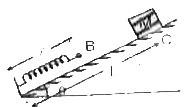There are hundred indentical blocks equally spaced on a frictionless track as shown in the figure . Initially , all the blocks are separate . Each collision is perfectly inelastic . The final velocity will be

V99
V100
zero
NONE
Step by step video & image solution for There are hundred indentical blocks equally spaced on a frictionless track as shown in the figure . Initially , all the blocks are separate . Each collision is perfectly inelastic . The final velocity will be by Physics experts to help you in doubts & scoring excellent marks in Class 11 exams.
Updated on:21/07/2023Topper's Solved these Questions
- CENTRE OF MASS, IMPULSE AND MOMENTUMBOOK - DC PANDEYCHAPTER - CENTRE OF MASS, IMPULSE AND MOMENTUMEXERCISE - Only one option is correct for JEE Advanced
55 Videos
- CENTRE OF MASS, IMPULSE AND MOMENTUMBOOK - DC PANDEYCHAPTER - CENTRE OF MASS, IMPULSE AND MOMENTUMEXERCISE - More a than one option is Correct
1 Videos
- CENTRE OF MASSBOOK - DC PANDEYCHAPTER - CENTRE OF MASSEXERCISE - Medical entrances gallery
27 Videos
- CENTRE OF MASS, LINEAR MOMENTUM AND COLLISIONBOOK - DC PANDEYCHAPTER - CENTRE OF MASS, LINEAR MOMENTUM AND COLLISIONEXERCISE - Level 2 Subjective
21 Videos
Similar Questions
There are hundred identical sliders equally spaced on a frictionless track as shown in the figure. Initially all the sliders are at rest. Slider 1 is pushed with velocity v towards slider 2. In a collision the sliders stick together. The final velocity of the set of hundred stucked sliders will be :

View SolutionThree identical blocks each of mass M are along a frictionless table and a force F is acting as shown. Which of the following statements is false ?

View Solution
Knowledge Check
Assuming all the surfaces to be frictionless accelration of the block c shown in the figure is
 A5m/s2B7m/s2C3.5m/s2D4m/s2
A5m/s2B7m/s2C3.5m/s2D4m/s2Three blocks of masses m , m and M are kept on a frictionless floor as shown in the figure .The leftmost block is given velocity v towards the right . All the collision between the blocks are perfectly inelastic . The loss in kinetic energy after all the collision is 5/6th of initial kinetic energy. The ratio of M/m will be
 A14B18C2D4
A14B18C2D4A 0.098−kg block slides down a frictionless track as shown in (Fig. ).
 .
.
The vertical component of the velocity of block at A isA√gB2√gC3√gD4√g
Three identical blocks, each having a mass m are pushed by a force F on the Frictionless table as shown in figure.
What is the net force on the block A?

View SolutionA 0.098−kg block slides down a frictionless track as shown in (Fig. 5.208).
 .
.
The time taken by the block to move from A to C is.
View SolutionA 0.098−kg block slides down a frictionless track as shown in (Fig. 5.208).
 .
.
The time taken by the block to move from A to B is.
View SolutionIn the figure shown, ma=mb=1kg block-A is neutral while block-B carries charge −1c. Sizes of A and B are negligible. Block-B is released from rest at a distance 1.8m from A. Initially spring is neither compressed nor stretched.

If collision between A and B is perfectly inelastic, then velocity of the combined mass just after collision is
View SolutionA block of mass 'm' is released on the top of a frictionless incline as shown in the figure. The time period of the oscillation of the block is

View Solution
